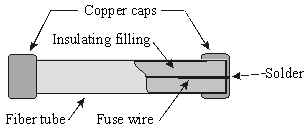Level 5 Applied Technology
The band saw where you work will not start. This saw uses 240 volts, draws 25 amps, and has 30-amp cartridge fuses. These fuses (see diagram shown) are designed to protect an electrical circuit. Their main component is a fuse wire made of a low-resistance, low-melting-point alloy. When a higher than tolerable current goes through such a fuse, this fuse wire melts. Your supervisor has told you to check the fuses in the band saw. By looking at the fuses, you cannot tell if they are good or bad.

You have turned off the power to the saw and removed one of the fuses. You check this fuse with a volt-ohmmeter (a device that measures resistance to the flow of electrical current).
Why this is a Level 5 item:
- The examinee must possess knowledge of fuses and Ohm's law.
- The examinee must understand the operation of a volt-ohmmeter.
- The examinee must solve a moderately complex problem by determining whether a fuse is working.
- There are some technical terms that are defined (volt-ohmmeter), some that are partially explained by context (alloy and ohms), and some that use both text and illustration (fuses).
- There is extraneous information.
-
3.
If the fuse is good, the resistance (measured in ohms) for the fuse will be: